From my recent diary
2013
Monday, December 30
It has been nasty weather for three weeks; though I got up many times at the
wee hours expecting the clear sky, I have not comet hunted since Monday, December
9. The sky had been clear during the daytime yesterday and today, but it
changed to cloudy after the sunset.
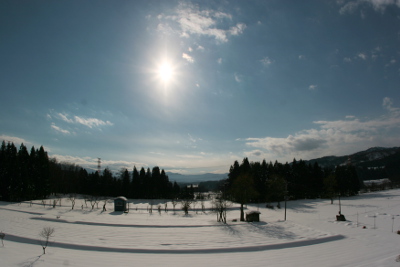
The photo was taken on Monday, Dec. 30.
I went up Sakato-Yama Mountain 633 m above sea level, 37˚03’32”N, 138˚53’55”E,
on Saturday. I saw a lovely scene of a stone figure of the Buddha in the snow.
A soft light casted a shadow of the statue on the snow. The comfortable weather
turned into a snowstorm in 30 minutes, but I could reach the top of the
mountain.
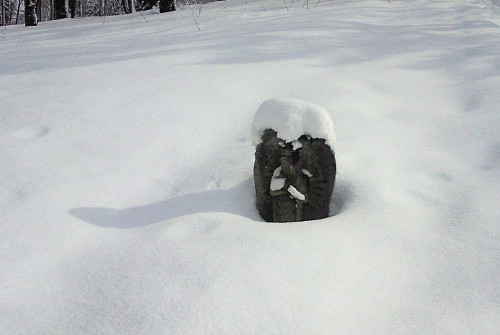
A stone figure of the Buddha partly buried in the snow.
The figure will be completely buried by the snow cover soon and we greet the New
Year.
Thursday,
December
5
I wake up a few
minutes before the alarm clock rung at 2:55a.m. The sky was
perfectly clear! I conducted a comet hunting session last Friday, and
this was
the first comet searching session since then. I got up at 3a.m. last
Sunday and
Monday expecting clear sky, but it was cloudy.
As the winter solstice approaches the time when I go on a comet hunting
became late.
While I was heading for the site by my car at around 3:30a.m. I saw
newsman on
the street. In early October for example, I drove before 3a.m. and
usually I see
no men on the street.
At the observing site I observed C/2013 R1 Lovejoy at first. With my 46
cm
comet-seeker it has a tail over 2 degrees in length. It was an ion tail
and
there existed a dark band in the tail that divided the tail into two
parts. The
comet was seen by naked eye but I could not see the tail since the
altitude of
the comet was only 20 degrees when I observed it at 4a.m. The tail
0.5degrees
long was easily seen by naked eye on Wednesday, Nov. 27 and Friday,
Nov. 29.
At 4:10a.m. I began to comet hunting from Alpha Corvi. The DSOs I
identified
were NGC3887, 3981, 4038-39, 3892, M68 and NGC4361. Those were galaxies
with
10th or 11th magnitudes except for the last two. I was a bit startled
to see
M68, a globular cluster in Corvus, as it looked like a comet but at the
next
moment I noticed what the object was; it was resolved into stars and I
realized
this old friend. At a glance NGC4361 also resembled a comet with high
degree of
concentration and I was taken aback but I remembered this planetary
nebula in a
second.
Speaking of
NGC4038-39 (antennae-galaxies), I
remembered I sketched these
galaxies in 2002 about two months before the
discovery of C/2002 E2 Snyder-Murakami.
I was enjoying the comet hunting session but gradually, the amount of
cloud
increased. Finally, the entire sky was covered with cloud at 4:53a.m.
about 20
minutes before the start of the twilight. I wanted to observe C/2013 R1
again
at higher altitude at 5a.m. A bit disappointing.
Sunday, November 17
Comet observation
In addition to C/2012 X1 LINEAR, C/2012 S1 ISON, C/2013 R Lovejoy and
C/2013 V3
Nevski got bright this month probably influenced by activation of the
sun as some
people said.
I did not conduct comet hunting session because of moonlight, but
observed
those comets at this predawn.
C/2013 R Lovejoy
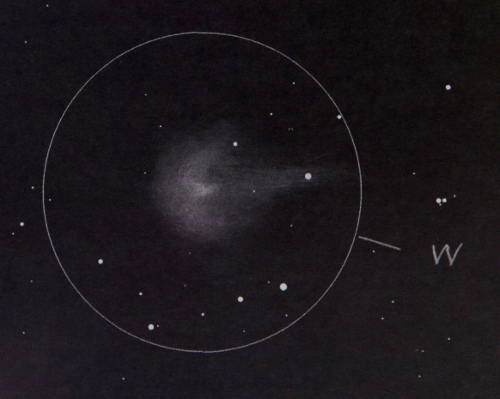
Sketch
Bright with a tail and looked blue-green colored. The degree of
concentration (DC)
was 6 3
(corrected on Nov. 18, 2013).
C/2013 V3 Nevski
As DC was 0, it was very difficult to see under the moonlight. The
comet was
easily noticeable with the comet filter. http://www.lumicon.com/2.htm
C/2012 S1 ISON
I have never seen a blue colored comet like this! With high DC (= 3
7) the color
was light blue
(corrected on Nov. 18, 2013).
C/2012 X1 LINEAR
I could not see this comet without the comet filter. Using the filter,
this
comet looked diffused and DC=0.
I tried to observe 2P Encke, but I could not due to haze near the
horizon.
Saturday, November 9
I got out of bed at 2a.m. and the sky was very clear. Leo rose above
the
eastern horizon magnificently. But I drove to the site with some worry;
the
forecast said it might be cloudy at predawn.
Three minutes before I reached the site I noticed the sky got cloudy. I
parked
my car and confirmed that 90% of the sky was covered with cloud. I
canceled the
session and drove back to my house.
At the parking of my residence, unbelievably, I found the sky
cloudless. I
doubted if it must be a fake clear sky and waited for 5 minutes.
However, it remained
fine. Again I drove to the nearest site and started to set up my
comet-seeker. Oh
my god! It got cloudy again in 10 minutes when I was setting up the
scope. I
wondered if I could enjoy clear sky this month again as I live in one
of the cloudiest
areas in Japan.
Wednesday, November 6
I woke up at 1:30a.m. JST and the sky was crystal clear, but it was too
early
to go on a comet hunting. I stayed in my bed until 2a.m. and crept out
of the
bed.
At the observing site I enjoyed Hose Head nebula that was easily seen
without a
filter, C/20013 R1 Lovejoy and C/2012 S1 ISON. After 10 minutes of star
gazing,
I began the hunting session from M47 as the Winter Milky Way was
attractive. The
first DSO I identified was Sh2-311, an emission nebula adjacent to an
open
cluster NGC2467 in the constellation of Puppis. NGC2438, a planetary
nebula in
M 46, was obvious. NGC2588 a faint open cluster looked nebula like
image at a
glance but it resolved into several 13th to 14th magnitude stars if you
peered at
the object.

The emission nebula, Sh2-311 adjacent to the open cluster NGC2467. The
image is
30 arc min. wide.
The Digitized Sky
Survey copyright©1994
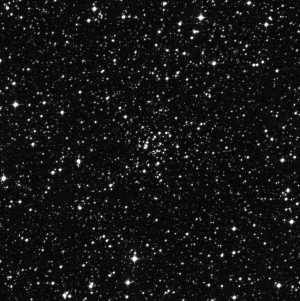
The faint open cluster NGC2588. The image is 15 arc minutes wide.
The Digitized Sky
Survey copyright©1994
After I identified some 11th and 12th galaxies, at 3:40a.m., suddenly,
seeing and
transparency turned bad at the same time. I must looked over many small
galaxies because it was challenging to distinguish small galaxies from
stars
that swelled due to poor scintillation, especially at a low altitude.
At 4:46a.m. I observed C/2012 X1 LINEAR and 2P Encke and I completed 2
hours of
long hunting session at 5:10a.m.
Saturday, November 2
Comet hunting session with a journalist
Clear sky! This week I got up five times at predawn including today,
and
finally, I encountered the cloudless sky. I comet hunted last on
October 11
15 (corrected on Nov. 4, 2013) ,
and since then I could not search due to moonlight and cloudy weather.
There
were some fine days during the daytime but not at predawn.
This situation is very similar to the discovery story of P/2010 V1
Ikeya-Murakami in 2010. At that time I conducted the comet hunting
session on
October 19 (Japan Standard Time, JST) before the day of discovery. The
day of
discovery was November 4 (JST) and the day after tomorrow is the third
anniversary.
Today, I got up at 1:45a.m. and drove to the site with a reporter of
The Asahi
(a major newspaper in Japan) who was waiting for me at 2a.m. at the
entrance of
my residence. He is a science reporter and writes an article on comet
searching
this month. He has already interviewed me on the comet searching last
month,
and today was the on-site interview. We arrived at the site at 2:25a.m.
and
enjoyed stargazing prior to the hunting session. C/2013 R1 Lovejoy was
bright with
a tail, while C/2012 S1 ISON at a low altitude (about 10 degrees above
the horizon)
was so faint that the reporter could not recognize it even using my 46
cm
comet-seeker. We also enjoyed some DSOs: M31, M42, M45, and h-kai
(double
cluster in Perseus). He said he was deeply impressed by an awful sky
that he experienced
for the first time. I believe his awesome experience makes an
attractive
article. The article will appear The Asahi on November 18.
I started the searching session at 3:25a.m. from some 5 degrees
southwest of
Regulus, alpha Leonid, as I did three years ago upon the discovery of
P/2010 V1.
Since the transparency on November 4, 2010 was much higher than that of
this
predawn I identified some 12th magnitude galaxies, but today I noticed
none of
the 12th magnitude one. Some 5 minute past 4a.m. C/2012 S1 came into
the FOV
during the hunting session. I told the reporter to try to see the comet
again and
he could observe the comet easily this time. At 4:30a.m. we observed 2P
Encke
and C/2012 X LINEAR. 2P got much brighter than in October. I observed
C/2012 X1
for the first time, and I had an impression that this comet image is
similar to
that of P/2010 V1. The reason is, as some scientists pointed out, both
C/2012
X1 and P/2010 V1 brightened due to the outburst. Photographic images of
C/2012
X1 resembles 17P Holmes also. 17P is famous because it outburst and
reached 2nd
magnitude in 2007. The fifth comet I observed was C/2013 N4 Borisov but
I only
recognized the existence of this object, i.e. I could recognize the
nucleus of
this comet.
Photo and sketch images
C/2012 X LINEAR
http://www.astroarts.jp/photo-gallery/special/243
P/2010 V1 Ikeya-Murakami
http://www.astroarts.jp/photo-gallery/special/81
http://homepage3.nifty.com/cometsm/sketch/comets/P_2010_V1.html
17P Holmes
http://www.astroarts.co.jp/gallery/comet/17p/index-j.shtml
I think this is the first time that I observed as many as four bright
comets (brighter
than 9th magnitude) at once. What a wonderful night with the reporter!
Monday, October 7
Superb sky! When I arrived at the observing site, it was easy to spot
the Gegenschein
(the counter glow) in the constellation of Pisces. It looked like an
edge on
galaxy, a round center with a pair of wings along the ecliptic plane.

The Gegenschein looked like an edge on galaxy as shown on this photo.
http://en.wikipedia.org/wiki/File:Gegenschein_above_the_VLT.jpg
The star image in the FOV was pinpoint with Paracorr (ocular:
Planokular 30 mm,
D=457 mm/f=2037 mm), it means 78x with the FOV of 1.1 degrees. Prior to
the
comet hunting session, I observed three comets; 2P Enke was bright and
defused
with a short tail, C/2012 S1 ISON was still dark and C/2013 R1 Lovejoy
was
bright also had a short tail.
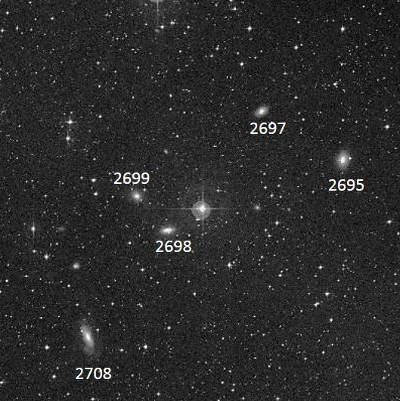
A galaxy group in Hydra.
The Digitized Sky
Survey copyright©1994
I started the session from the north of Procyon, apopha Canis Monoris.
The
first galaxy I identified was NGC2555 in Hydra, the second was NGC2538
in Canis
Minor, both were12th magnitude. As the
transparency was excellent, unexpectedly, I identified those faint
galaxies.
The third was a galaxy group, NGC2708,
2695, 2698 and 2699. The photo above contains NGC2697 that was too dark
to be
seen. I thought this was the first time I identified this group, but
when I
opened a map, Uranometria 2000, to identify NGC number of each one I
found the
underlines for those objects; I have ever observed the group. I saw many
meteors in the FOV during the session and suddenly, a flash light
penetrated the darkness. It must be released from a fire ball that I
could not
see.
It was a
wonderful predawn.
Wednesday, September 18
Moonset was at 3:40a.m. and the twilight started at 4a.m. I enjoyed
only 20
minutes of dark sky. I started the hunting session at 3:25a.m. from M42
in the
same way as that on September 4 when I missed C/2013 R1. This time I
used 78x
magnification combining Planokular 30 mm eyepiece with Paracorr 2. The
star
image is pinpoint and the FOV becomes flat with Paracorr. But I stopped
using
Paracorr after the discovery of P/2010 V1 Ikeya-Murakami since the
actual FOV
reduces from 1.3 degrees to 1.1 degrees by applying Paracorr. Using
Paracorr or
not? Both are correct.
The objects identified were the reflection nebula in NGC2232 and C/2013
R1. I
was satisfied with beautiful stars in the flat field and completed the
session
at 4:35a.m.
I will appear on TV program next Sunday (on air in domestic only). The
title of
the program is Galileo X, and this is the 61st story: “The great Comet,
ISON is
coming: a fossil of the Solar system that records the state of the
Universe of
4.6 billion years ago”.
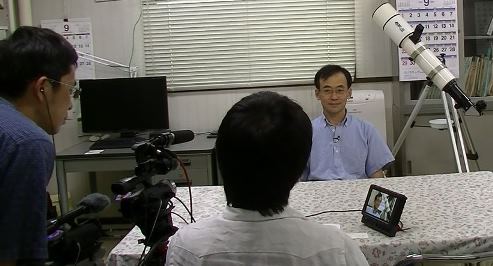
I got interviewed on comet hunting.
Web
pages of the TV program.
http://web-wac.co.jp/program/galileo_x/gx130922
http://www.bsfuji.tv/top/pub/galileox.html
Major casts:
Junichi Watanabe (NAOJ), Shigeki Murakami (amateur), Seiichi Yoshida
(amateur),
Yoichiro Nakashima (amateur), Hideyo Kawakita (Kyoto Sangyo Univ.), and
Reiko
Furusho (NAOJ)
It was somewhat hard to get interviewed, because the coverage involved
both indoor
interview and outdoor one. At predawn a scene of a comet hunting
session was
shot. It had been cloudy and rainy those days, and I worried about
raining. Fortunately,
the day when the TV staff planned to shoot the comet hunting session
was cloudy
with some cloud gaps. I hope many people will have interested in comets
by watching
this program and Comet ISON gets the great comet.
Tuesday, September 17
A typhoon has passed and the weather forecast predicted the clear sky.
At
2:20a.m I finished setting up my comet-seeker at the observing site.
Prior to
the searching session, I trained my telescope at C/2013 R1 Lovejoy that
was at
an altitude of 20 degrees. With 68x magnification the comet was not
seen, but I
noticed it with 78x. In my impression the possibility of discovering
this comet
with 78x was 40% to 50%. With 92x magnification the chance of discovery
was 70%
to 80%.
After observing Comet Lovejoy I began the hunting session, but
suddenly, the
amount of clouds increased and I had to wait until 2:50a.m. to resume
the
session. The motion of clouds was rapid and sometimes the entire sky
was
covered by clouds. The only comet-like object identified was NGC1788, a
reflection nebula.
At 4:00a.m.the time when the twilight began I observed C/2013 R1 again.
The
comet was at an altitude of 37 degrees and seen 68x magnification with
the
chance of discovering of 10% to 20%. I also observed C/2012 S1 ISON but
the
magnitude was 13th by intuition. I tried to see C/2013 N4 Borisov and I
could spot
extremely faint image of this comet for the first time.
Wednesday, September 11
The discovery of C/2013 R1 Lovejoy has been
officially announced. I observed
this comet today with a magnification of 157 using my 46 cm
comet-seeker.
However, the comet was not seen with 68x in the same way with C/2012 S1
ISON
that I observed last Wednesday.
C/2013 R1 Lovejoy
September 10.715, 2013 UT
Magnitude: 12.7, apparent diameter: 2.6’, the degree of concentration
(DC): 2.
As I mentioned in the previous daily, I swept the sky area where C/2013
R1 was on
today last week (September 4) before the discovery. Today I confirmed
the position
of the comet and found that I missed discovering this comet by a hairsbreadth! I identified NGC2110 at around
2:40a.m. on Sep.
4 (JST) and amazingly, the comet was in the same FOV with NGC2110 at
that time.
The comet was not seen with 68x, the usual magnification I use, but was
easily noticeable
with 157x at this predawn. If only I changed the eyepiece to Ethos 13
mm (157x)
to confirm the suspicious object, NGC2110, I could have discovered the
comet,
as the distance between the comet and the galaxy was only 25’.
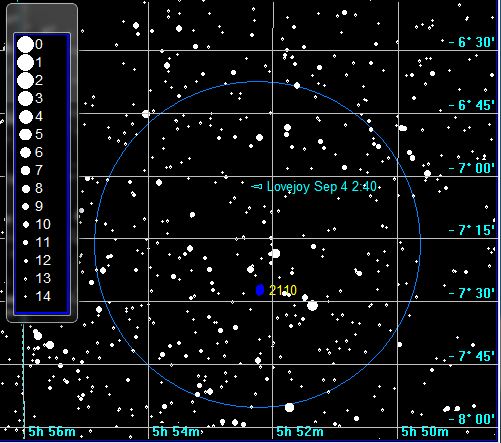
C/2013 R1 and NGC2110 in the same FOV. The circle represents 1.3
degrees
for 68x. September 3.736, 2013 UT (before
discovery).
After observing C/2013 R1, I comet hunted the River Eridanus. I
identified two galaxies, NGC1417 and 1600. When M79, a globular cluster
in
Lepus, came into the FOV at 3:15a.m. the sky began to be covered by
clouds. In
10 minutes the sky was overcast.
Wednesday,
September 4
I had been waiting for the clear sky, and finally I could comet hunt on
Wednesday. Later at home I looked at the weather chart and I was
surprised; the
front was over my city at the time of the comet hunting session but the
sky was
clear. However, star images in the FOV of my comet seeker were very
unstable.
Seeing was extremely poor at the beginning of the searching session and
in
several minutes later it recovered to moderate condition. In 10 minutes
it
became bad again. Such a pattern was repeated many times during the
session.
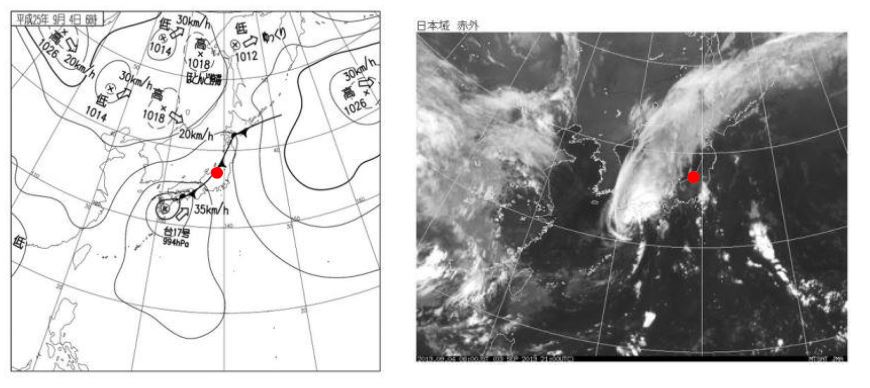
The weather chart and the satellite image at 6a.m. on Sep. 4, 2013.
The red dots indicate the location of my city.
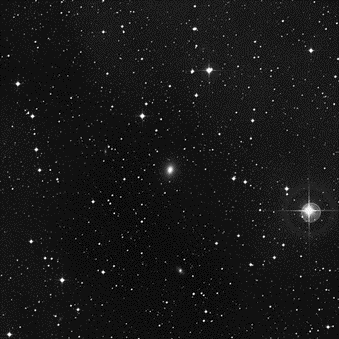
NGC2110. This is a Seyfert galaxy. The image is 30’
wide.
The
Digitized Sky Survey copyright©1994
I aimed my comet-seeker at M42, the great Orion nebula and started the
session
from there. Some 5 minutes after the beginning of the session, I
encountered a
double-star-like object. I peered at the object and I tried to believe
it as a
double star, but I could not since the image was stable; if it was a
double
star the stars’ image must deform with time due to air turbulences but
it did
not. I checked the object using the digital setting circles and it
turned out
to be NGC2110, a 12th magnitude galaxy in the constellation of Orion.
The
apparent diameter was around 1.5’ and it was difficult to distinguish
it from a
double star because of bad seeing. Anyway, I was satisfied to identify
this
galaxy at an altitude of 18 degrees.
At this session I had a plan to observe C/2012 S1 ISON. I tried to
observe it
at 3:52a.m. The expected magnitude was 12 to 13, but it seemed to be
challenging because of bright zodiacal light. I could see nothing at
the
position with the magnification of 68 but succeeded in identifying the
comet
with 157x. The altitude of the comet was 15 degrees. Later in the
session I also
identified NGC2170.
Surprising news!
While I was writing this manuscript, the Japanese comet mailing list
announced that
a new comet was discovered. The position was within the area where I
covered on
Wednesday! The official announcement has not made yet, but discoverer
was Terry
Lovejoy and it will be named C/2013 R1 Lovejoy. The comet was not
bright enough
to be detected with my comet-seeker.
Sunday,
September 1
In August it has been unstable and nasty weather nationwide and I could
not
comet hunt at all due to the poor meteorological condition. Even if the
sky was
clear in daytime, it turned into cloudy during the night. I have paid
attention
to the forecast and I got up when the clear sky was expected; however I
was
always clouded out.
For example, the chances were clear sky at predawn on August 29 and I
got up at
1:30a.m. and 2:00a.m. but it was in vain. Ironically, at 8a.m. the sky
was
cloudless but it changed into overcast at the night.
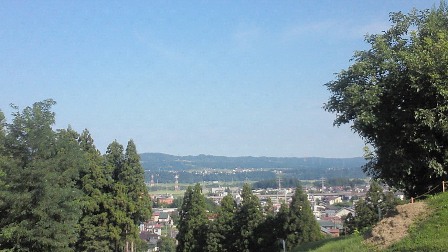
At 8a.m. the sky was cloudless on August 29.
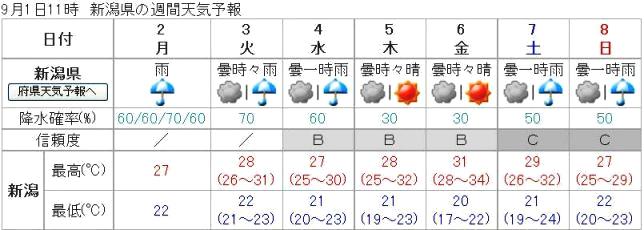
Weekly forecast announced on September 1.
I remembered that there were less fine days in August, and I checked
the record.
I conducted comet searching sessions 2 nights in 2008, 3 nights in
2009, 6
nights in 2010, one night in 2011 and 8 nights in 2012. The variation
was very
large, but I think I have been able to comet hunted every August in the
past.
I comet hunted last on July 9, and I could not since then. I wonder if
I can on
Thursday or Friday.
Friday, August 9
It has been cloudy and rainy since I comet hunted last on 9 July,
though the
meteorological agency announced the end of the rainy season on 3 August.
I made setting circles that I have had a plan to make for many years. I
used
silver colored spray paint for painting and draw graduation by a
felt-tip pen.
I have ever encountered a sudden dead of battery, while I was using the
NGC Sky
Vector during the comet hunting session. It is hard to deal with such a
situation,
especially when you spot a possible comet. Setting circles work out
when it
comes to such an accident.
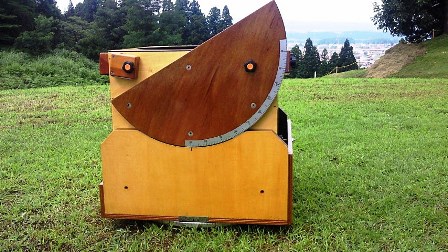
Setting circles of azimuth and altitude
|
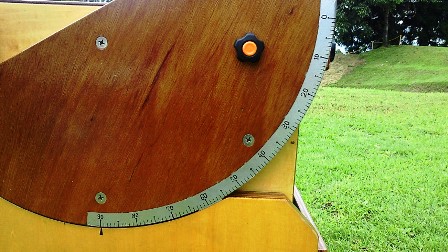
Altitude circle
|
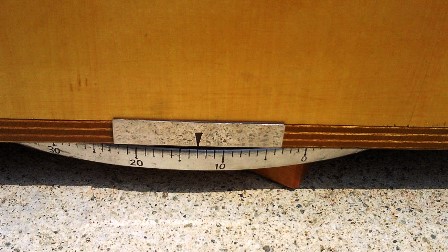
Azimuth circle 1
|
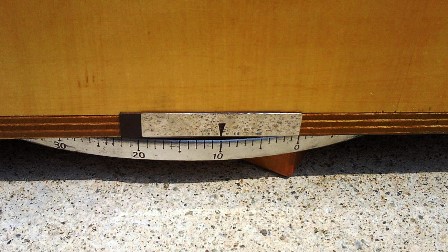
Azimuth circle 2
|
If you can level the telescope at the time of setting, altitude circle
indicates the correct value. You can level it within 0.5 degrees
easily. But it
is almost impossible to set the zero point of the azimuth scale to the
north.
Assuming that the azimuth scale indicates 13.0 degrees (shown in photo "Azimuth
circle 1"), and actual azimuth angle of
Antares is 180.1 degrees. The azimuth
angle indicator is made of thin stainless steel plate and is fixed on a
sheet
of magnet. The plate is easy to slide. If you move the indicator (the
plate) to
the azimuth angle of 10.1 degrees (shown in photo "Azimuth
circle 2"), the difference between
actual azimuth and the scale is 170.0
degrees. You can see the azimuth angle by adding 170.0 to the indicated
azimuth
scale.
By combining the setting circles and iPod appri, the altitude and
azimuth of
DSO or the center of the screen is shown; you can identify DSOs when
the NGC
Sky Vector does not work.
Tuesday, July 9
I was happy to go on a comet hunting this
week as I expected, though the rainy season (Baiu) has not yet finished
officially. I went to the site where I visited on daytime two weeks
ago, and
this was the first time I set my comet-seeker on the site. It took some
25
minutes by car from my residence, 7 or 8 minutes farther than the usual
site,
but the longer drive paid off. The eastern sky is darker than at the
usual
site.

|

|
The left image is 20’ wide and the right one (NGC779) is
15’.
The Digitized Sky
Survey copyright©1994
I started with the hunting session at 1:30a.m. from Deneb Kaitos, beta,
Ceti. The
first DSO I observe was NGC132, a dark galaxy in Cetus. It was 12th
magnitude
and looked like a planetary nebula as the surface brightness was
homogenous.
NGC584, 596 and 615 group passed through the FOV and I noticed all of
them
easily. Another galaxy group, NGC467 and 474 in Pisces happed to come
into the
FOV at 3:05a.m. over 20 minutes after the start of the twilight. NGC470
(shown
on the photo) was too dim to see with my 46 cm comet-seeker. In a few
minutes
very elongated galaxy, NGC779 (11th magnitude) in Cetus, was
impressive, but it
was not the last one. NGC488, a 10th magnitude galaxy, was bright
enough to be seen
clearly 30 minutes after the start of the twilight.
When I was taking down my telescope, cloud began to spread all over the
sky.
Sunday, July 7
I had a plan to go on mountain climbing
today, but it was canceled due to rainy weather. We have few clear
skies at
this time, now that it is rainy season.
Comet hunting activity has been similar situation. I have not been able
to comet
hunt since June 13 because of moonlight and nasty weather.
At predawn on June 13 the sky condition was
excellent but the amount of cloud was more than 70% throughout the
session. Soon
after the start of the session, I encountered M33. Then, a galaxy group
in Pisces
that includes NGC507 and another faint one came into the FOV. The
altitude of
the galaxy group was some 20 degrees and the magnitudes of these
galaxies are
11th and 12th, respectively. NGC507 was easy to identify using the
digital
setting circles. However, as I forgot to bring my iPod in which “Deep Sky
browser” is installed, I could not identify the darker galaxy
exactly using the
digital setting circles: there are many galaxies in this area.
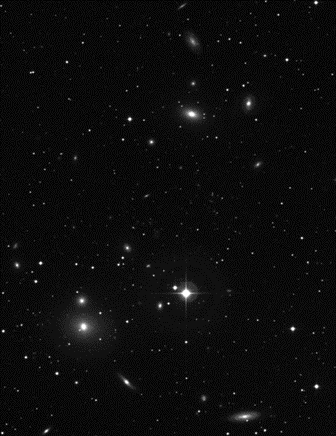
NGC507 (lower left) and NGC499 (upper center).
The
Digitized Sky Survey copyright©1994
I opened Uranometria 2000 but it took over 5 minutes to identify darker
one, NGC499.
It might be a strategy to believe darker one must be a member of the
group skipping
the check using a map and to go ahead. But I did not want to do so at
that
time.
At the latter half of the session, cloud covered the eastern sky, and I
trained
my comet-seeker at the north, the only cloudless direction. Suddenly, I
came
across a bright object. A new comet? Ruthlessly, the NGC Sky Vector
identified
it as NGC2655 (10th magnitude) in a second. I was not familiar with
objects in the
northern sky where I rarely search. I also noticed NGC2715 (magnitude
of 11.4)
in the same FOV.
I believe the rainy season (Baiu) will end this week and I can enjoy
deep sky
objects again.
Saturday, June 8
Light pollution
So far I could comet hunt three times in June. In addition to the
hunting
sessions I wanted to enjoy observing deep sky objects at dusk, and I
went to an
observing site on Monday June 3. My wife also wanted to do a star
watching and
we drove to one of the best sites where a 40-minutes-drive from our
residence. We
arrived at the site before the end of the twilight. To our
disappointment, the
sky did not get dark after the end of the twilight and it looked very
bright mainly
due to light originated from the baseball game grounds several
kilometers away.
The sky had been bright as if the twilight had been about to start.

Figure 1 Light source around the observing site.
http://tsunanbaseball.blog.fc2.com/blog-entry-11.html
http://pds2.exblog.jp/pds/1/200703/10/49/e0037849_0261195.jpg

Figure 2 Light
pollution in Japan.
The tail of
C/2011 L4 PANSTARRS was not conspicuous because of the light pollution.
We observed some Messier objects; the most impressive one was M13. We
observed
some other globular clusters but as they say, I completely agreed that
M13 is
the most beautiful globular cluster in the northern hemisphere. M57 was
also
very interesting, though I could not recognized the central star. I
have often encountered
these objects during the hunting sessions, but observing a certain
object
spending a lot of time and changing the eyepiece offer different kind
of fun.
At 10a.m. the
ballgames seemed to be over, and the sky was getting dark. Then,
we saw we were the member of the awesome universe. At this time the
degree of light
pollution was the same with that of predawn. Figure 1 shows the light
sources.
The triangles around the site in the figure indicate the origin of the
lights.
The thicker the line of the triangle is, the worse. The strongest light
source
at the site is Tohkamachi, where we live. Tohkamachi is a small city,
but there
is nothing to intercept the light between Tohkamachi and the site,
which makes it
the strongest light source. The light from Yuzawa is cut by the
mountain range.
The second strongest is Nagano and Jyoetsu, and the third is Tokyo area
including Gunma (Takasaki and Maebashi).
If you look at
the entire Japan (Figure 2), Tohkamachi area is very nice place
for star watching in terms of darkness of the sky, but even so, light
pollution
at dusk is serious enough to disappoint most people.
Wednesday, May 22,
2013
Wonderful sky of the last Saturday
Today was the last dark predawn before the full moon on Saturday
,May 25. Although
it was cloudless at predawn, I did not go on a comet-hunting due to
yellow sand
from Chinese dessert. It made the sky very hazy.
So far, I conducted seven comet hunting session this month, and the
session of
the last Saturday, on May 18, was the most enjoyable among them. This
month I have
been disappointed at hazy sky mainly caused by the yellow sand from
China, but
this time the sky was hazy free. In addition to that I went to the new
observing
site for the first time where I have looked beforehand last year. The
site is 660
m above sea level and took 30 minutes from my residence, while the
usual site
is 370 m and 15 minutes. When I approached there at the end of April,
the road
was covered with snow and I could not reach the site.
When I arrived at the new site, all the stars looked “larger” in
apparent diameter
and they seemed to be cheerful. I could see the 6 th magnitude stars
and M13
with my direct vision. I could see the faint part of the Milky Way in
the
constellation of Ophiuchus.Before the start of the session, I enjoyed
some deep
sky objects with 50mm x8 binocular and my 46 cm comet-seeker: M8, M13,
M22, M51
and Veil nebula. Every object looked much brighter than usual and was
impressive
with any aperture! I must say it is worth visiting farther site.
The hunting session in itself was not special. I began with M72 at
1:50a.m., I
have to get up very early at this time of the season, and only two DSOs
were
identified: M30 and M2. But the dark background made me comfortable.
Before
3a.m. I trained my telescope at C/2011 L4 PANSTRRS. The ion tail
stretched over
one degree, and the angle between this tail and wider dust tail was
some 165
degrees. C/2012 F6 Lemmon looked brighter than C/2011 L4, but the dust
tail was
short. I enjoyed a quick look at those comets and resumed the searching.
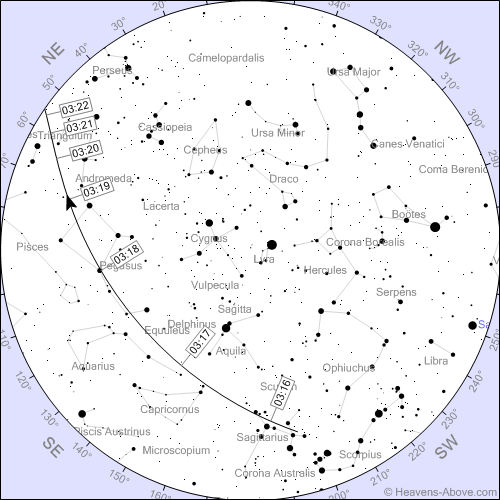
International Space Station passed through Pegasus.
http://www.heavens-above.com/
At 3:18a.m. when I looked at the east by naked eye, International Space
Station
passed through the quadrangle of Pegasus. At the same time I noticed
Fomalhaut
rose above the horizon. I completed the session at 3:35a.m.
Friday, May 10
C/2012 F6
Lemmon and fire-ball on May 6
I conducted comet hunting sessions
four times in May
including today’s one. Unfortunately, transparency of the sky was
moderate or
poor all the time as is always the case with this season. Among them
the
session on Monday May 6 was the most impressive.
I trained my comet-seeker at the south-southeastern sky, since the
eastern sky
was very hazy that intensified the light pollution while the south is
the only light-pollution-free
direction. I began with M22, a globular cluster in Sagittarius. I
observed
several meteors passed through the field of view (FOV) during the
session;
today was the maximum of the Eta
Aquariids. The first deep sky object (DSO) that appeared in the FOV
except for
M22 was NGC6723 in Sagittarius that is located near the boundary of
Corona
Australis. The other DSOs identified this session were M54, NGC6712 and
M75.
The crescent moon, beautiful as a goddess, rose from the hill. At
3:00a.m. I
tried observing C/2012 F6 Lemmon for the first time, but I could not
due to
haze and too low altitude of the comet. I tried again at 3:35a.m. and I
successfully
observed this comet. I also noticed short tail of the comet.
I completed the session at 3:45a.m. and started to take down the
telescope.
Suddenly, at 4:00a.m. something emitted a flash of light. I thought it
must be
a fire-ball and looked up the sky quickly. I managed to observe the
fire-ball
before it disappeared and the meteor trail moved like a snake afterward.
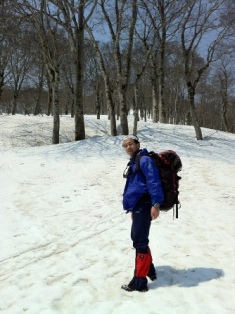
Nabekura-yama
It was national holiday today, and I went to a small mountain,
Nabekura-yama,
1288 m above sea level (36°58’35.6”N,
138°22’56.4”E) on daytime. The mountain was
the paradise of the
skiers where the snow depth was some 2 m and there is a beautiful old
Japanese
beech forest. I recharged the battery with the hike.
Tuesday, April 23
C/2013 E2
Iwamoto and C/2011 L4 PANSTARRS
I started
a comet hunting session at 2:58a.m.
a few minutes before the moonset. Several minutes later after the
moonset when
I looked up the sky, the Milky Way was splendid with higher luminosity.
The twilight
began at 3:25a,m. and I could enjoy the dark sky only some 25 minutes.
Lyrids
was its peak this predawn. Luckily, I saw a 1st magnitude Lyrids
meteor.
During the session I identified merely two deep sky objects: M2 and
M15. The
highlight of this predawn was observation of comets. Unexpectedly,
C/2013 E2
Iwamoto was bright; magnitude: 11.3,
diameter: 2.3’, DC: 2. At first I thought the
cause of easy observation of this comet was due to excellent
transparency, but
I noticed the comet brightness actually increased when I measured the
brightness.
Another comet I had been wanted to observe was C/2011 L4 PANSTARRS. I
saw this
comet last on April 5 when it was near M31. At that time the
transparency was
very poor and tails were not observed. This time not only the dust tail
but
also the iron tail was easy to observe. I did not make an observation
for brightness.
The angle between the two tails was 120 degrees and there existed
gaseous
material between the tails that formed fan-shaped tail as a whole. It
looked
more beautiful than photo images!
I finished the session at 4:00a.m.
Thursday, April 18
Urania observatory
I have been in Vienna, Austria, last week to attend a scientific
conference as
a forest hydrologist. While I was there I happened to find an
astronomical
observatory. http://www.planetarium-wien.at/

Urania observatory
The explanation shown on the wall of the building was written in German
and I
could not understand. Anyway, I entered the building and went up to the
floor
where the telescope dome is. The doors were locked and no one was
there. When I
decided to give up contacting a staff, I saw a man walking over the
glass wall.
I spoke to him and he said he could show me the telescope.

|
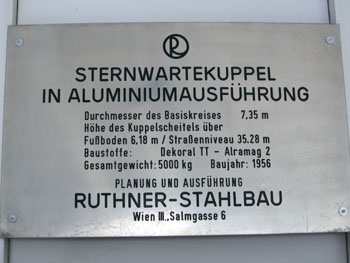
|
| Telescopes |
Face plate in the dome |
The telescopes were 15 cm and 10 cm refractors for solar
observation with Cassegrain reflector. He
showed me the sun using refractors.
Seeing at that time was superb and there were many sunspots when I
peered the 10
cm refractor using a solar filter. He installed a H alpha filter and
Pentax XL 40
mm eyepiece on the 15 cm telescope. I have ever seen the H alpha solar
image a
few times, but this image was the best! I enjoyed spectacular image for
several
minutes.
He said the observatory was built in 1910, but was destroyed in the
war. This
building was rebuilt in 1956. The war is crazy.
Friday, 22 March
C/2013 E2 Iwamoto
This is the 5th comet hunting
session in
March. Though air temperature was -4 deg. Celsius, I felt it was much
colder. I
think this was because my body was accustomed to warm climate on
daytime. I
started with M16. Transparency at a low altitude was poor and I could
not identify
M55. NGC6539 and M75 that seemed to be a comet at low altitude were
comet like
objects I identified during the session. NGC6712 and M11 were
spectacular
including the star ground around these objects. I must say the field of
view (FOV)
was gorgeous with numerous stars that showed various colors and
decoration by dark
nebulae. These objects came into the FOV one after another. It was as
if the FOV
had been filled with open clusters all the time.

M11 and the star ground. The width of the image is 2 deg.
http://wikisky.org/
At 4:20a.m. one hour after the beginning of the session, I aimed my
comet-seeker at C/2013 E2 Iwamoto. I could not recognize the comet with
68x,
and increased the magnification up to 155x using Ethos 13 mm. Many
stars looked
like the comet since the star image was swelled due to bad seeing. At
the
position of the comet I barely saw dim image of the comet. It was 13th
magnitude with a diameter of 0.5’. It was impossible to spot the comet
during
the session under such poor seeing and transparency. Anyway, I was
happy and
satisfied with observing the comet discovered by Japanese
Saturday, 16 March
C/2013 E2 Iawmoto, C/2011 L4 PANSTARRS and
273P Pons-Gambart
New comet C/2013 E2 Iawmoto was discovered by a Japanese! The discovery
was
made using digital camera. I think visual discovery of this comet must
be
difficult even with my 46 cm comet-seeker.
Actually, I swept near the position of the comet on Friday, 15 March. I
began
with the session from Altair, alpha Aquilae, at 3:25 a.m. (14.7674 UT),
when
the comet was only 3.5 deg. above the horizon and I think the discovery
had not
yet announced. The difference in azimuth between Altair and the comet
was only
0.5 deg. that meant the comet was in the field of view of my
comet-seeker if
tree height near the horizon was lower than 3.5 deg. Even if the trees
did not
hide the comet, it was impossible to spot such a dark object with an
altitude
of only 3.5 deg.
I tried to observe this comet today, but I was clouded out at 4:10 .am.
when the
altitude of the comet was still low: 12deg. Photo magnitude was
announced to be
13 to 14, but some visual observers reported it as 12th magnitude.
However, visual
discovery was challenging. The important thing is that this discovery
demonstrated that we, amateurs, still have a chance of discovery.
Today, I observed 273P Pons-Gambart prior to the comet hunting session.
I
estimated the magnitude was 12.5 by intuition, which was difficult to
spot during
the hunting session even with the altitude of 70 deg if not impossible.
I observed C/2011 L4 PANSTARRS on Tuesday, 12 March for the first time
using 20
cm reflector and 7x50 mm binocular. The comet was also observable with
6x30 mm
finder, but not by naked eye since there is a hill with an altitude of
5 deg. at
the site and the comet set over the hill before the sky getting dark
enough. I
also took a photo of this comet on Thursday, 14 March which well
reproduced
visual image of the binocular.

C/2011 L4 PANSTARRS
Click to enlarge
Data is here
This is the fourth comet hunting session in March. Yesterday, Friday
15, it was
very cold with temperature of -9 deg. Celsius, while today it was -1
deg.
Ironically, the lower the air temperature gets, the more beautiful the
star
field looks. Nothing ventured, nothing gained.
The Chinese comet hunter Wentao Xu sent me a
composite image of corona,
the totality in Australia, and I replaced old one with this. In my
impression this is one of the most real images I have ever seen which
reproduced the visual image.
Sunday, 17 February
On Friday a meteorite fell down in Russia, Chelyabinsk
Oblast, and the shock wave injured over 1,000 people with
damages of many buildings and facilities. On Saturday Asteroid 2012
DA14 went through
only 27,700 km above Earth’s surface; I could not observe it because of
snowy
weather. The orbits of those two asteroids were
completely different but it is surprising Russian meteorite explosion
occurred the
day before the close pass of 2012 DA14.
This reminds me that in 2008 a few meters sized
asteroid, 2008 TC3, was discovered and predicted to enter
the earth’s
atmosphere after 20 hours of the discovery. Surprisingly, after the
collision, fragments
of the meteorite were collected over the Nubian Desert of northern
Sudan. The
Russian meteorite was much larger than 2008 TC3, but the robotic survey
was
failed to spot it and cased unexpected damage. The survey could not
detect the
Russian asteroid because it came from the direction of the sun.
You must remember that the survey does not cover not only the direction
of the
sun but also the low altitude of the sky at dusk and predawn. I
discovered a
comet on February 26, 2004 that was not confirmed and was lost. I
believe the
comet was the near earth object that moved with a high speed and no one
confirmed
after my discovery. Minoru Honda and an anonymous Japanese comet hunter
said
they encountered comets with quick motion which they could not report
due to
high speed. I think there are still many near earth objects that the
survey
fails to detect. Chances are you can still discover new comets, which
may even
threat the earth.
I have read somewhere that the chance of the meteorite collision to the
earth with
a comparable size of the Tunguska explosion in 1908 would be
one-in-100-year (Yeomas
et al. estimate 300 years). I
felt the estimation was reliable to hear the news of Russian meteorite
on
Friday, but luckily the size of the meteorite was much smaller than
that of Tunguska.
If it has been the same as Tunguska, some 1,000 times (Yeomas
et al. estimate 185 times) as
strong as Hiroshima atomic
bomb, the damage would have been devastating; on top of the harm of the
explosion itself the nuclear facilities in the Chelyabinsk
Oblast would be destroyed that could cause severe radioactive
contamination like Chernobyl or
Fukushima.
Yeomas et al.
Besides the impacts of asteroids and comets, we are threatening various
natural
disasters.
The other day, Richard Brown, the Australian comet hunter told me the Siding
Spring Observatory had fire and was about to be burned down. As a
result, it
was safe but in Australia fire is a major risk that people encounter in
their
daily life. The fire runs with speed of 100 km/h and it is impossible
to escape
from the raid.
Similarly, in Japan earthquakes and tsunamis are
serious threat that we sometimes cannot avoid.
We, human beings, have a potential to spot asteroids or
comets that threat our planet and avoid the catastrophe using
technology. However,
in some cases the extinction of human kind caused by the impact of the
objects is
unavoidable. We are fortune to live and must feel grateful to our
ancestors who
have been developed our civilization for tens of thousands of years.
Utilization of nuclear energy, whether accidents like Chernobyl or
Fukushima at
the atomic power plants occurs or not and whether it is military
purpose or not,
damages DNA that can die out many kinds of species including us.
http://www.radiation.org/index.html http://www.nucleardemolition.com/SF.pdf
We never use
science and technology for vice. Those who have power want to keep
using
nuclear energy because it is equivalent with nuclear weapons; they want
to have
nuclear weapons. I must say Fukushima Prefecture except for Aizu, the
western part
of the prefecture, will disappear in a several years. Tokyo area is not
a safe place
to live especially to raise children. We should not harm ourselves
anymore and must
stop using nuclear energy; even if this is not the case, we may be
extinguished
by the impact of asteroid or comet.
Friday, February, 1
I comet hunted for the first time this year. I
arrived at the observing site at
3:25a.m. and started the hunting session at 3:55a.m. under the
moonlight.
I trained my comet seeker at M12, a globular cluster in Ophiuchus, and
began
with the searching session from this globular cluster. Messier 12 was
dim because
of bad seeing and the moonlight. At the next moment M10, which looked
brighter than
M12, came into the FOV. As cloud covered a part of the sky for a while,
the only
Deep Sky Object I identified except for M10 and M12 was M14.
As time went by the number of stars in the FOV increased because the
telescope
moved into the Milky Way area. I remembered that when I discovered
C/2002E2
Snyder-Murakami I began to the comet hunting session from Ophiuchus,
the same constellation
I started searching this predawn. This comet was discovered in the
Milky Way.
I tried observing 273P Pons-Gambart for the first time at 4:35am. but I
failed
to do. Then, this comet must pass through the FOV at around 5a.m. but I
did not
notice. At about 10 minutes past 5a.m. I tried to see the comet again
and I
found a very faint object, however I was not sure if it was the comet.
At
5:25a.m. I aimed my comet seeker at 273P again and confirmed the faint
object
was the comet! It was 10th magnitude and it was difficult to
spot
this comet during the hunting session under the moonlight. I was happy
to
observe the comet that returned 185 years after the discovery.
Thursday, January 24
I got up and looked up the sky at 3a.m. but it was overcast again. This
predawn
was the last chance to have a comet hunting session this month. The
next predawn
must be snowy and the waxing moon makes visual hunting difficult the
day after
tomorrow. I got out of bed at predawn three times in January, but as a
result I
had never comet hunted. OK, no need to worry. This is the norm here in
this
area.
Ironically, the sky was very clear for a few hours after the sunrise.
The
surface of the snow was frozen early in the morning, but it melted as
the sun
rose higher. The footprint of a rabbit on the snow was impressive.
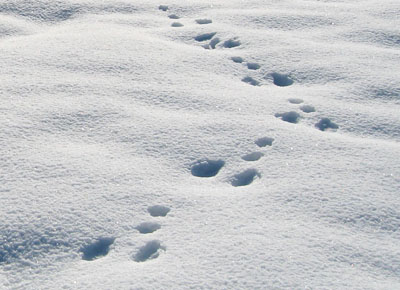
Foot print of a rabbit on the snow.
On Saturday 12 the sky was clear and I went to comet hunting at
predawn. It was
very cold with a breeze and the air temperature was -9 degrees Celsius.
I
thought it was one of the chilliest predawns I have ever experienced
while
comet hunting. While I was setting up my comet-seeker, filmy cloud
gradually appeared,
and five minutes before I completed assembling the scope it got
overcast. On
the same day at dusk I set up the telescope again to observe C/2012 K5
LINEAR.
This time the sky was perfectly clear. When I aimed my comet-seeker at
the
comet, thin cloud started to spread. The comet was faint then I
expected due to
the light pollution caused by the ski fields. Just when I changed the
eyepiece for
higher magnification, the comet disappeared; it got overcast again. I
saw the
comet only three minutes. Do not worry; it was much better than see
nothing.
Sunday, January 6
Yesterday, it was very clear in the morning, but cloudy until sunrise.
I wish
the sky had been clear at predawn.
I went skiing in the morning and could see my usual observing site from
the ski
field. The ski field was 20 minutes from my house by car, and I looked
down at
the site in farm land from the upper part of the ski slope. The red dot
on the
photo shows the site where I discovered P/2010V1 Ikeya-Murakami and
255P Levy
that was not my discovery officially.
The photo was taken at the ski field, “Nakatato Kiyotsu”, 4 km
south-southeast
of the observing site: 138°41’40”E, 38°01’26”N, 375 m a.s.l..
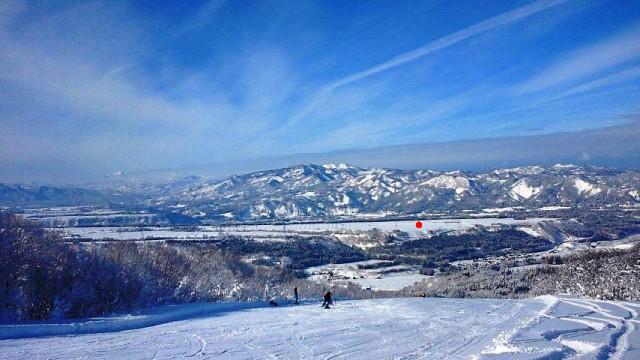
The red dot shows the observing site where I discovered P/2010V1 Ikeya-Murakami and 255P Levy.

Beech trees at the top of the ski area.
The forecast said it will be snowy or cloudy through this week, but I
should
pay attention to the weather. It may be off the mark unexpectedly.
Top of this page


















